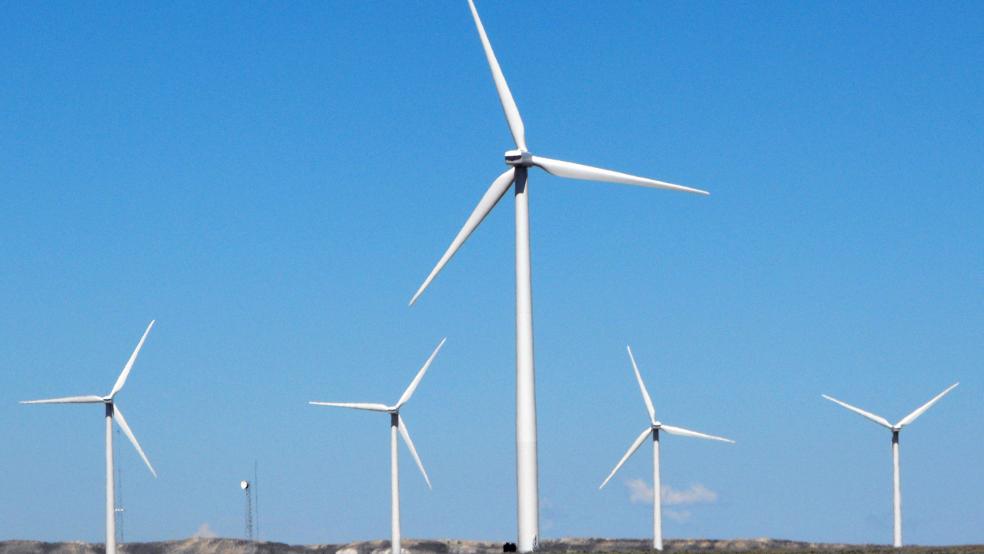Last week, Xcel Energy announced a multi-state wind capacity project, anticipated to be the largest in the United States. Spanning seven states, the project covers eleven new wind farms and would generate 3280 MWs at a cost of $3.5-4.4 billion. In its announcement, Xcel emphasized the cost-savings attached to wind power, arguing that it would save Xcel customers in the Midwest $7.9 billion over thirty years. This, rather than the environmental benefits of renewable energy, drove the company’s mission statement: wind was cheap, not just clean.
Increasingly, this is a line of argument companies involved in renewable energy are deploying, finding that it gets better traction from skeptical consumers and fidgety investors. Existing tax credits, most notably the production tax credit (PTC) that keeps costs low, as well as a tax rebate per kilowatt hour. These help wind compete with natural gas as a cheap source of electricity and has driven the surge of utility interest in harnessing wind power, despite the much-touted promises of President Donald Trump to bring back American coal.
Related: Here's Why Trump Won't Be Able to Keep His Promise Coal Miners
Moody’s Investor Services now estimates that the falling costs of wind power directly threatens 56 GW of coal power, out of 87 GW surveyed. Moody’s report estimates the MW-hour cost of wind in the Great Plains region at around $20, while coal comes in at $30.
Total U.S. wind energy capacity grew 19 percent in 2016 and reached 5.5 percent of total generating capacity, outstripping hydroelectric as the nation’s largest source of renewable energy. Much of the surge in added capacity came from power companies and utilities eager to take advantage of the PTC before it is cut from 80 percent to 60 percent.
The author of the report noted that it was economic, not environmental logic that is driving utilities to adopt wind power, as Xcel plans to do. “Yes, it’s good for the environment and the consumers benefit from having cleaner power at a cheaper price, but at the end of the day, it is pursued by the utility because it is much more cost-effective.”
The PTC is already set to decline to 20 percent by 2019, and will be phased out after that. The decision to renew the credit in 2015 largely drove the current rush of investment. Those economic arguments tend to emphasize short-term gains, as the federal government has recently indicated it plans on eliminating many of the previous administration’s clean power regulations. That would threaten wind power’s cheap appeal and cause it to lose its competitive edge over natural gas.
Related: Gas Prices Are Rising: Here’s How Much Filling Up Will Cost This Summer
But the surge of investment in wind power may spur on additional growth, especially if the price of natural gas increases (as the EIA predicts it will, by 2018). Berkshire Hathaway Energy Renewables, an energy developer owned by Warren Buffett, purchased a 400 MW project in Nebraska, while another Buffett company, MidAmerican Energy, bought 551 MW of wind online in Iowa, a state with the second-largest total wind capacity, 6,917 MW according to the American Wind Energy Association.
With these investments, Iowa expects $3.6 billion pumped into nearly 2000 MW of wind power capacity between 2017 and 2019. The interest of investor-owned utilities is matched by public utility companies in Iowa, Minnesota, North Dakota and elsewhere. Improving turbine technology is expected to further drive down costs, while innovation (such as new offshore projects in North Carolina and New York) will display wind power’s versatility.
It’s enough to make proponents of wind power optimistic, at least for now. There are reasons to believe that wind, even without the advantages of the PTC, can out-compete coal and even natural gas. Moody’s estimates that without the tax credit, wind costs increase to about $40 per MW hour. But further improvements in technology could drive that cost down.
Utilities like it because it protects customers from volatility in the fossil fuels markets. These arguments and the chance to add capacity at little cost in the short term, rather than the environmental advantages, are the main justifications for putting up new turbines nationwide.
For now, those justifications are enough to attract investors like Xcel and Buffett. But long-term, competition with natural gas for the utilities market will be fierce, particularly if gas prices remain low. The effects of federal regulation and legislation from Congress could shift advantages from renewable energy to coal. The EIA estimates that without tax credits, the costs of constructing and maintaining equal capacity wind power and natural gas power plants are nearly the same: $58.50 per MW-hour versus $56.40.
Right now, investing in wind power makes sense for utilities, allowing them to downplay the environmental arguments. But if the economic rationale for clean energy begins to wane, it’s possible that rhetoric around wind, as well as solar power, could shift once more.
This article originally appeared on OilPrice.com: Read more from OilPrice.com:
Pro-Extension Voices In OPEC Become Louder




